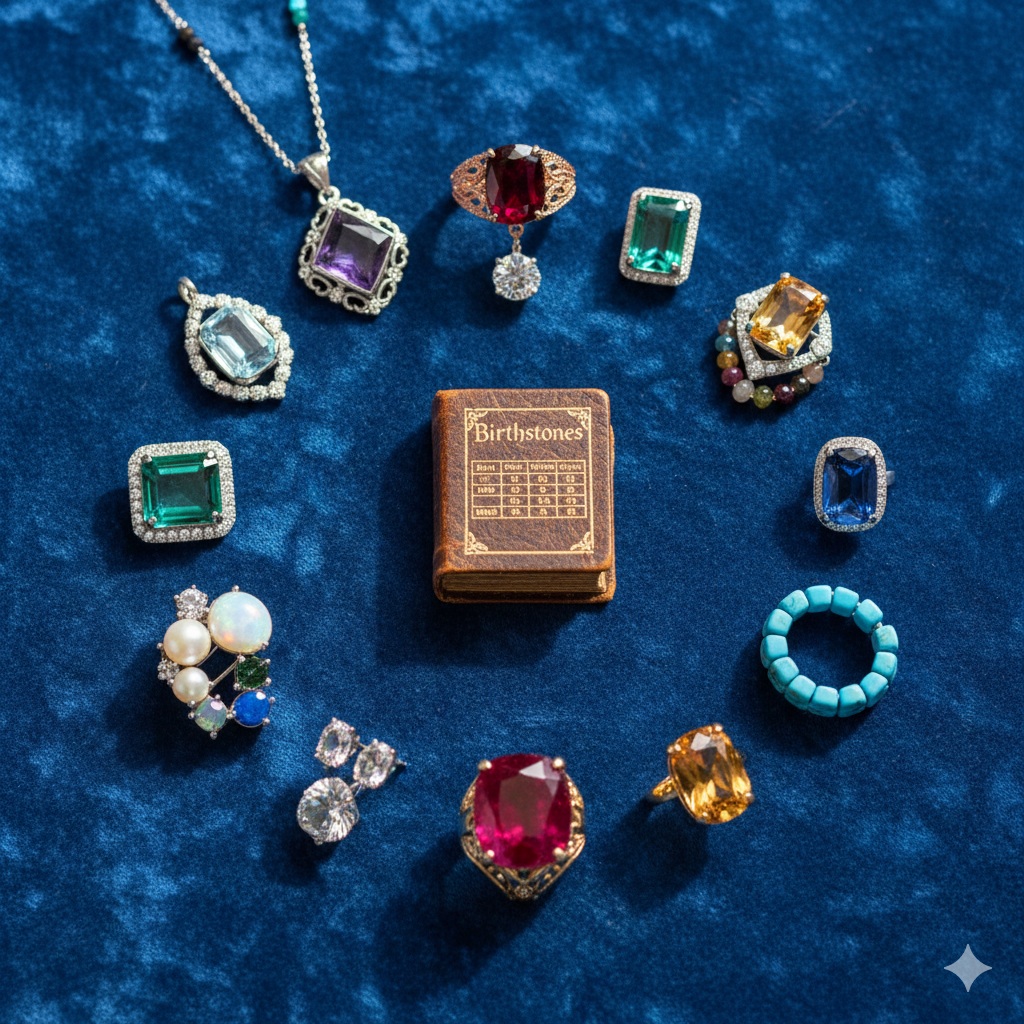The Ultimate Guide to Birthstones: Meanings, History, and the Complete Month-by-Month List
Looking for the perfect piece of personalized jewelry? Few items are as meaningful or deeply personal as birthstone jewelry. These captivating gemstones, assigned to the twelve months of the year, connect us to history, culture, and ancient symbolism.
Whether you’re curious about the birthstone for your month or seeking the history of birthstones, this comprehensive guide covers everything you need to know about these precious and semi-precious stones. Discover the origins, the modern birthstone list, and the unique properties that make each gem special.
The Complete Official Birthstone List (Month-by-Month)
The modern birthstone list, largely standardized by the Jewelers of America (JA) and often referenced by organizations like GIA, provides a consistent stone for each month. Below is the full birthstone chart with colors and key symbolism.
| Month | Primary Birthstone | Color | Symbolic Meaning |
| January | Garnet | Deep Red | Protection, Faith, Friendship |
| February | Amethyst | Purple | Wisdom, Sobriety, Clarity |
| March | Aquamarine / Bloodstone | Light Blue / Green w/ Red | Courage, Hope, Health |
| April | Diamond | Clear/White | Eternity, Invincibility, Purity |
| May | Emerald | Green | Love, Rebirth, Fertility |
| June | Pearl / Alexandrite / Moonstone | White / Color-Change / Opalescent | Purity, Integrity, Balance |
| July | Ruby | Red | Passion, Power, Nobility |
| August | Peridot / Sardonyx / Spinel | Light Green / Banded Brown | Protection, Strength, Healing |
| September | Sapphire | Blue (Various) | Truth, Royalty, Serenity |
| October | Opal / Tourmaline | Multi-Color / Various | Hope, Creativity, Innocence |
| November | Topaz / Citrine | Yellow/Orange | Joy, Strength, Abundance |
| December | Turquoise / Zircon / Tanzanite | Blue/Violet/Blue-Green | Success, Fortune, Tranquility |
Birthstone Meanings and Symbolic Properties
Every gemstone on the official birthstone list is believed to hold unique powers and historical significance. Understanding the birthstone meaning adds depth to your birthstone jewelry.
- January Birthstone: Garnet 🍷The Garnet birthstone is thought to keep the wearer safe during travel and is often associated with the heart and blood. It is a symbol of deep, enduring friendship and trust.
- February Birthstone: Amethyst 💜The gorgeous purple Amethyst gemstone was historically worn by royalty. It is prized for its soothing qualities, promoting clarity and quick wit. It was once believed to prevent intoxication, hence the meaning of sobriety.
- March Birthstone: Aquamarine 🌊Aquamarine, the March birthstone, draws its name from the Latin word for seawater. Sailors believed it protected them at sea. It symbolizes youth, courage, and health. The alternative stone is Bloodstone, a deep green jasper with red flecks.
- April Birthstone: Diamond ✨As the hardest substance on Earth, the Diamond is the ultimate symbol of eternity, love, and invincibility. Wearing the April birthstone is thought to enhance relationships and increase inner strength.
- May Birthstone: Emerald 💚The stunning green Emerald has long been associated with Venus, the Roman goddess of love. The May birthstone represents rebirth, fertility, and successful love. Its rich color is a symbol of spring.
- June Birthstone: Pearl, Alexandrite, and Moonstone 🦢June is one of two months with three birthstones. Pearl symbolizes purity. Alexandrite is famous for its dramatic color-change effect (green in daylight, red in incandescent light). Moonstone offers a milky, opalescent shimmer, symbolizing intuition and balance.
- July Birthstone: Ruby ❤️🔥The Ruby birthstone is one of the most highly-valued precious stones. Historically associated with warriors and royalty, it is believed to bring good fortune and protect the wearer. It symbolizes passion and power.
- August Birthstone: Peridot and Spinel 🟢The bright, lime-green Peridot is sometimes called “the evening emerald.” The August birthstone is said to protect the wearer from nightmares and bring good luck. The alternative stone, Spinel, is an excellent, durable gem that occurs in a wide spectrum of colors.
- September Birthstone: Sapphire 💙Renowned for its deep blue color, the Sapphire is the September birthstone. It has been a favorite of priests and royalty for centuries, symbolizing truth, wisdom, and nobility. It is second only to the diamond in hardness.
- October Birthstone: Opal and Tourmaline 🌈October is another month with two birthstones. Opal is famed for its “play-of-color,” displaying a mesmerizing rainbow effect. Tourmaline offers the largest color range of any gemstone—it can be virtually any color. Both stones are linked to creativity and artistic expression.
- November Birthstone: Topaz and Citrine 🧡The rich, warm hues of Topaz and Citrine represent joy and abundance. Topaz is the more historically recognized November birthstone, though Citrine (often mistaken for Topaz) has grown in popularity due to its lovely golden-yellow color and affordable price.
- December Birthstone: Turquoise, Zircon, and Tanzanite ❄️December holds the distinction of having three official birthstones. Turquoise is a striking opaque blue-green stone associated with good fortune. Zircon is prized for its brilliance. Tanzanite, the newest addition, is a beautiful blue-violet gem found only in Tanzania.
The History of Birthstones and Their Biblical Origin
The tradition of birthstones can be traced back thousands of years. The most commonly cited origin is the Breastplate of Aaron (or the High Priest’s Breastplate) described in the Biblical Book of Exodus.
This ceremonial garment was adorned with twelve different gemstones, each inscribed with the name of one of the twelve tribes of Israel. Early scholars linked these twelve stones to the twelve months of the year, the twelve signs of the zodiac, or the twelve apostles.
However, the practice of wearing a stone that corresponds to your actual birth month is a more modern phenomenon. For many centuries, it was customary to own all twelve stones and wear a different one each month for its specific properties. The shift to wearing only the gemstone tied to one’s own month is believed to have gained popularity in 18th-century Poland.
The Modernization of the Birthstone Chart
Over time, different cultures and jewelers created conflicting lists. To provide consistency for consumers and the jewelry trade, the National Association of Jewelers (now the Jewelers of America) officially adopted and standardized the modern birthstone list in 1912.
This standardization helped establish the official birthstones we recognize today. Subsequent updates have been made to the list to include newly discovered or more accessible gemstones, such as adding Tanzanite for December and Spinel for August.
Caring for Your Birthstone Jewelry
To maintain the brilliance and longevity of your birthstone jewelry, it’s crucial to understand the care requirements of your specific gem.
- Hardness Matters: Gemstones are rated on the Mohs scale of hardness. Softer stones (like Opal, Pearl, and Turquoise) are more susceptible to scratches and damage. Always store softer stones separately from harder ones (Diamond, Sapphire, Ruby).
- Avoid Chemicals: Remove your birthstone jewelry before swimming, cleaning, or applying lotions and perfumes, as harsh chemicals can damage or dull many stones, especially Pearls and Turquoise.
- Cleaning: Most durable gemstones (Sapphire, Diamond, Amethyst, Garnet) can be safely cleaned with warm water, mild soap, and a soft brush. Softer stones like Opal or Pearl should only be wiped gently with a damp cloth. Never use ultrasonic cleaners on fracture-filled or porous stones.
Whether chosen for its dazzling beauty or profound symbolic meaning, a birthstone is a deeply personal connection to a moment in time. Explore the complete birthstone list and find the perfect gem to celebrate your or a loved one’s special birth month.
Ready to transform your passion for jewelry into a professional skill?
Diamgold in South Africa offers specialized Jewelry courses designed for aspiring gemologists, designers, and bench jewelers. By enrolling, you can delve deep into practical topics such as Diamond Grading (the 4 C’s), Gemstone Identification, advanced CAD software for jewelry design, and the intricacies of manufacturing techniques. These hands-on courses provide internationally relevant knowledge and certification, giving you a competitive edge whether you plan to launch your own brand, work in retail, or specialize in gemology. Take the next step toward a rewarding career by mastering the art and science of fine jewelry at Diamgold.
Editor Comment
That is an excellent transition! We’re thrilled this comprehensive guide to birthstones and their profound meanings sparked interest in professional gemology. As the Editor of 24hourdiamondnews.com, we want to highlight the exceptional opportunity at Diamgold Academy. With over 50 years of collective industry experience, Diamgold offers specialized, accredited jewelry courses—from Rough Diamond Evaluation and Diamond Grading (essential for understanding every birthstone) to advanced Jewelry Design and Manufacture. If you were captivated by the history and symbolism of the Ruby or Sapphire, imagine mastering the skills to design, grade, and set these precious gemstones yourself. Diamgold’s programs, based in South Africa, are designed to meet international standards, preparing you for a successful career in the global jewelry market. Discover the true value behind the official birthstone list—enroll in a Diamgold course today to elevate your expertise!”

